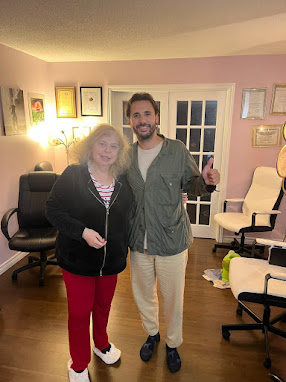Spasmodic Dysphonia Treatment: Our Mission is Quality Personalized Voice Care! We also pay special attention to the "sensitive and afraid"...
There could be numerous causes for that nasty and serious disorder.
Interestingly enough, the voice of the sufferer is greatly
compromised; however, it is only a symptom and not the cause. The causes could be induced by emotional,
psychological and neurological traumas.
For example - a tragic event happens and a switch between
autonomous actions that are coordinated between the brain and the control
function of the neck, thyroid and larynx becomes affected. As a result, the
‘voice user’ experiences uncontrollable spasms within the neck
structure/muscles and other areas that may not have been recorded, especially if they were not ever searched for.
Of course, it could also be due to the misuse of
one’s voice, as well as via contracted viruses such as a severe infectious cold, flu, strep
throat and whatnot.
I personally compare this nasty disorder to epilepsy and, in this context, I actually call it “Vocal Epilepsy”
The traumas also could be caused by negative environmental
surroundings by means of air-born pollution. Chemicals that affect (and
sometimes degrade) the cells within the brain that control autonomous motor
functions within the body, may possibly result in spasmodic dysphonia as well.
Also, chemical agents like industrial strength detergents,
bleach, and dangerous drugs like meth amphetamines, non-professional man-made
hallucinogens, etc, can play a role in causing an environmentally-induced version of spasmodic dysphonia.
Now let’s find out about non-surgical treatments for this
disorder.
My answer is yes, it is; but with great difficulty and only
if it is not passed stage one, or maximum, two. I categorize this disorder
into 4 stages (just like cancer, God forbid). So, if it is in the light or
medium stage (stage one or two), the speech of the sufferer can be greatly
improved.
When it comes to stage 3 and especially stage 4 (when you
hardly hear a straight and clear speech), it is definitely much harder to greatly improve one’s condition.
Sometimes, spasmodic dysphonia disorder arises from the
condition, which is known as Muscle Tension Dysphonia. In one of my previous
blogs, I described a case where a person with muscle tension dysphonia
disorder contacted me in the past, but for some reason, she did not take me
up on my offer to give her instruction and treatment (when it was still possible to achieve some meaningful results). Later on, she contacted me
again and told me that presently she had been diagnosed with Spasmodic Dysphonia. I
asked her to give me a call before I would give her my commitment. She did and
I, unfortunately, could hardly understand a word she had been saying.
She sounded like her condition, at that time, would be classified close to stage 4.
With all honesty, I told her that I would not be able to
attend to her case with a guarantee (even employing my absolute best efforts) of any significant results. Unfortunately, in
that particular case, the Non-Surgical (and I believe, even Surgical) treatment
of any kind would be obsolete now.
There is a saying: “Time is healing”; but sometimes the
time has passed when the voice repair could still be done. But too much time passing by can also be detrimental, and thus it can bring this serious voice condition to the point of no return.
Via special speech and breathing exercises, coupled with certain body movements, I can knock down a good amount of spasms and teach the
person how to speak above them.
By learning a new application of the proper use of the voice, the
person would learn how to lift their voice off of the vocal box and off of the vocal
cords while using a different set of muscles such as the sinus cavities (facial
muscles). They, in turn, will begin to work in full conjunction and coordination with the
abdominal muscles designed to help to achieve greater support of the ‘lift’ of the sound.
The sound will become much clearer, and less intermittent. The voice of the person of interest, nevertheless, will sound more clear, and thus more pronounced and annunciated. The specially designed breathing exercises will help immensely to reduce spasms. All of that could bring a person
close to a definitive recovery; provided, of course, that the disorder is not
too far advanced.



